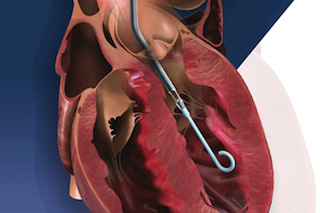
Part of our efforts at UT Southwestern is to evaluate how new technology can help us more safely care for your heart. Some new techniques offer only minor advantages over older approaches, while others advance the field in important ways.
Our team doesn’t add new technology just to have it. There has to be a meaningful advantage to the patients we serve. One such device is the Impella 2.5 system, which is the world’s smallest heart pump. This device allows you to get safely through high-risk coronary stent procedures in a safer, more predictable way.
The biggest advantage for you is safety – we believe this device allows you to get safely through high-risk procedures, and we hope your hospital stay will be shorter and less complicated. The Impella 2.5 allows us to open up more vessels, which in the long run we believe will allow you to feel better and possibly live longer.
What is Impella 2.5?
The FDA-approved Impella 2.5 is a mini heart pump, and it’s pretty amazing. We use it to support your heart during interventional procedures like percutaneous coronary interventions, angioplasty, or stenting.
Imagine you have two or three arteries blocked because of coronary artery disease. Opening those arteries takes time, and if you do not tolerate the procedure very well, your blood pressure can drop to dangerous levels. To prevent that, our team can insert the Impella 2.5 to keep your blood pressure and flow in a safe zone while your physician opens your arteries.
The Impella 2.5 is inserted through an artery in your leg, across the aortic valve, and into the left ventricle of your heart. There is a console (imagine an iPad on a stand) that we use to monitor things like blood flow and pressure. The console allows us to dial the flow up and down as appropriate. It also has many alerts for your medical team to monitor.
I generally insert the Impella 2.5 at the beginning of the procedure and remove it at the end. The patient often returns to the room without the device in place. However, in very sick patients, the Impella device could be kept in place for two to three days as we determine the right therapy for you.
Before the Impella 2.5, we used a balloon pump inserted through the groin. Over the years, we learned that the balloon pump was not great at maintaining blood pressure and flow for high-risk patients. The heart typically pumps about 4 liters of blood to the rest of your body; balloon pumps can handle about 0.5 liters, but the Impella 2.5 can pump 2 to 3 liters. Our larger Impella devices can pump 3.5 to 4 liters.
Use in high-risk patients
The patients who benefit the most are those at high risk for complications. We consider the use of the Impella device in patients with:
- Weakened heart muscle. If you have congestive heart failure, a low ejection fraction, or diminished heart function, your heart's pumping capacity may be so low as to make heart procedures risky."
- Co-morbidities. This includes people with advanced age, diabetes, kidney disease, prior stroke, and blockages in their leg arteries.
- Advanced heart disease. These patients have significant blockages in all three arteries.
If you have one or more of these conditions, the Impella 2.5 may provide effective heart support throughout your angioplasty or stenting procedure.
Mutually beneficial
The Impella 2.5 is also beneficial for your physician. It makes the procedure more predictable, allows for better control of blood pressure, and leads to a reduction in stress for the medical team.
The Impella 2.5 is a relatively safe device. Like any other procedure in cardiology, the biggest risk is bleeding from the insertion site. Also, the device can move, which is when the monitors become very important. Your cardiology team will keep a close eye on the monitors to be sure we’re in the right area of your heart, doing the right thing. The monitors will alert us when there’s something wrong. Your nursing staff and medical team know what to look for to ensure a safer, more effective outcome for you.
There are patients who have been told, “We can’t do anything for you. You have heart disease. I know you’re short of breath, I know you have chest pain, but you are at such high risk, I’m not comfortable fixing your heart.” Those patients may now be eligible for care because the Impella 2.5 enables us to deliver advanced care in a safer way.










